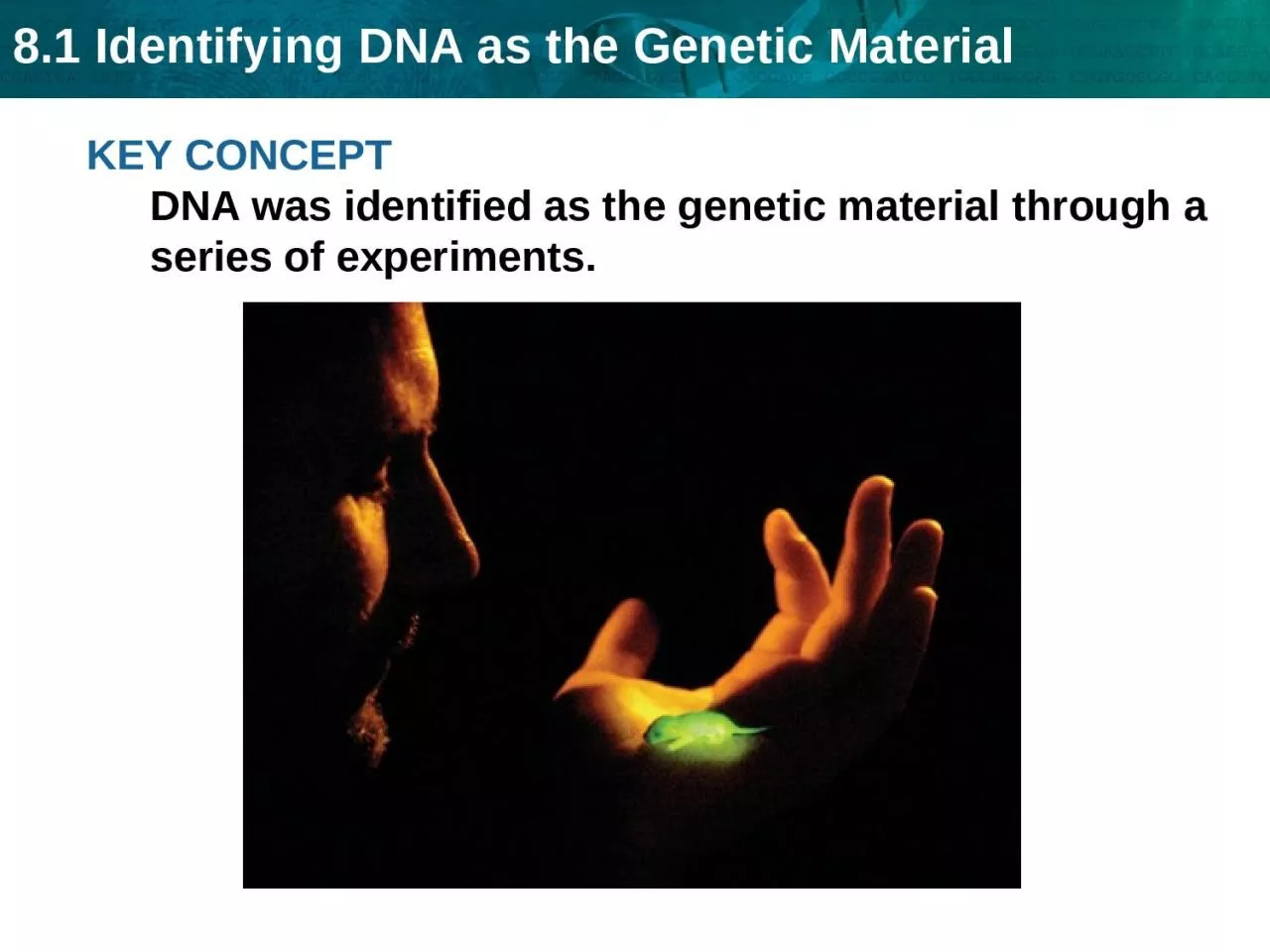

Griffith finds a transforming principle Griffith experimented with the bacteria that cause pneumonia He used two forms the S form deadly and the R form not deadly A transforming material passed from dead S bacteria to live R bacteria making them deadly ID: 1014841
Download Presentation The PPT/PDF document "KEY CONCEPT DNA was identified as the g..." is the property of its rightful owner. Permission is granted to download and print the materials on this web site for personal, non-commercial use only, and to display it on your personal computer provided you do not modify the materials and that you retain all copyright notices contained in the materials. By downloading content from our website, you accept the terms of this agreement.
1. KEY CONCEPT DNA was identified as the genetic material through a series of experiments.
2. Griffith finds a ‘transforming principle.’ Griffith experimented with the bacteria that cause pneumonia.He used two forms: the S form (deadly) and the R form (not deadly).A transforming material passed from dead S bacteria to live R bacteria, making them deadly.
3. Avery identified DNA as the transforming principle. Avery isolated and purified Griffith’s transforming principle.Avery performed three tests on the transforming principle.Qualitative tests showed DNA was present.Chemical tests showedthe chemical makeupmatched that of DNA.Enzyme tests showedonly DNA-degradingenzymes stoppedtransformation.
4. Hershey and Chase confirm that DNA is the genetic material. Hershey and Chase studied viruses that infect bacteria, or bacteriophages. Tagged DNA was found inside the bacteria; tagged proteins were not. They tagged viral DNA with radioactive phosphorus. They tagged viral proteins with radioactive sulfur.
5. KEY CONCEPT DNA structure is the same in all organisms.
6. DNA is composed of four types of nucleotides.DNA is made up of a long chain of nucleotides.Each nucleotide has three parts.a phosphate groupa deoxyribose sugara nitrogen-containing basephosphate groupdeoxyribose (sugar)nitrogen-containingbase
7. The nitrogen containing bases are the only difference in the four nucleotides.
8. Watson and Crick determined the three-dimensional structure of DNA by building models. They realized that DNA is a double helix that is made up of a sugar-phosphate backbone on the outside with bases on the inside.
9. Watson and Crick’s discovery built on the work of Rosalind Franklin and Erwin Chargaff.Franklin’s x-ray images suggested that DNA was a double helix of even width.Chargaff’s rules stated that A=T and C=G.
10. TACGNucleotides always pair in the same way. The base-pairing rules show how nucleotides always pair up in DNA.Because a pyrimidine (single ring) pairs with a purine (double ring), the helix has a uniform width. A pairs with T C pairs with G
11. The backbone is connected by covalent bonds.hydrogen bondcovalent bondThe bases are connected by hydrogen bonds.
12. KEY CONCEPT DNA replication copies the genetic information of a cell.
13. Replication copies the genetic information. A single strand of DNA serves as a template for a new strand.The rules of base pairing directreplication.DNA is replicated during theS (synthesis) stage of thecell cycle.Each body cell gets acomplete set ofidentical DNA.
14. Proteins carry out the process of replication. DNA serves only as a template. Enzymes and other proteins do the actual work of replication.Enzymes unzip the double helix.Free-floating nucleotides form hydrogen bonds with the template strand.nucleotideThe DNA molecule unzips in both directions.
15. Polymerase enzymes form covalent bonds between nucleotides in the new strand.DNA polymerase enzymes bond the nucleotides together to form the double helix.DNA polymerasenew strandnucleotide
16. DNA replication is semiconservative. original strandnew strandTwo molecules of DNATwo new molecules of DNA are formed, each with an original strand and a newly formed strand.
17. There are many origins of replication in eukaryotic chromosomes.DNA replication starts at many points in eukaryotic chromosomes.Replication is fast and accurate. DNA polymerases can find and correct errors.
18. KEY CONCEPT Transcription converts a gene into a single-stranded RNA molecule.
19. RNA carries DNA’s instructions. The central dogma states that information flows in one direction from DNA to RNA to proteins.
20. The central dogma includes three processes.RNA is a link between DNA and proteins.replicationtranscriptiontranslation Replication Transcription Translation
21. RNA differs from DNA in three major ways.RNA has a ribose sugar.RNA has uracil instead of thymine.RNA is a single-stranded structure.
22. Transcription makes three types of RNA. Transcription copies DNA to make a strand of RNA.
23. Transcription is catalyzed by RNA polymerase.RNA polymerase and other proteins form a transcription complex.The transcription complex recognizes the start of a gene and unwinds a segment of it.start sitenucleotidestranscription complex
24. RNA polymerase bonds the nucleotides together.The DNA helix winds again as the gene is transcribed. Nucleotides pair with one strand of the DNA.DNARNA polymerase moves along the DNA
25. The RNA strand detaches from the DNA once the gene is transcribed.RNA
26. Transcription makes three types of RNA.Messenger RNA (mRNA) carries the message that will be translated to form a protein.Ribosomal RNA (rRNA) forms part of ribosomes where proteins are made.Transfer RNA (tRNA) brings amino acids from the cytoplasm to a ribosome.
27. The transcription process is similar to replication. Transcription and replication both involve complex enzymes and complementary base pairing.The two processes have different end results.Replication copiesall the DNA;transcription copiesa gene.Replication makesone copy;transcription canmake many copies.growing RNA strandsDNAonegene